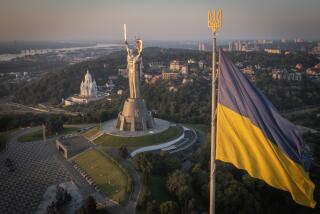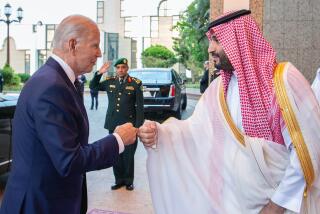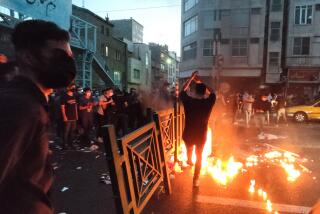Did the first lady’s uncovered head really rankle Saudis?
- Share via
President Obama’s hastily arranged trip to Saudi Arabia was intended to shore up relations with a key U.S. ally. But it was the attire of the first lady that was the focus of much of the discussion on social media -- at least in the U.S.
Obama cut short a high-profile trip to India to fly to Riyadh on Tuesday to pay respects to the family of the late King Abdullah and meet with his successor, King Salman.
First Lady Michelle Obama dressed conservatively for the visit in loose black trousers, a blue tunic and a long, brightly colored jacket. But she did not wear a head scarf, as required of the kingdom’s female subjects.
Many Saudi women appear in public in a face-covering veil known as the niqab, and some Twitter users appeared to take offense, even though the kingdom does not require foreign women to abide by the same rules.
A number of tweets included photographs of the first lady wearing a head scarf during a visit to Indonesia in 2010 and asked why she did not do the same in Saudi Arabia, which is home to Islam’s holiest sites, Mecca and Medina.
“In Indonesia she’s modest and in the country of monotheism she’s unveiled,” protested one user in Arabic.
But others defended the American first lady.
“Enough nonsense,” one snapped. “She wore hijab [a veil] in Indonesia because she visited a mosque there.”
Another tweeted: “God almighty says: To you your religion and to me mine. She’s not Muslim so why do we force her to wear the veil?!”
The whole issue appears to have attracted significantly more attention in the U.S. than in Saudi Arabia, where officials are accustomed to receiving Western visitors who do not veil.
The BBC Monitoring service, which tracked the discussion on social media, noted that a hashtag that translates roughly as “Michelle Obama with no head scarf” was tweeted about 2,500 times -- a not insignificant number, but hardly overwhelming in a country with large numbers of users. By contrast, a hashtag noting that King Salman had interrupted his visit with the Obamas to go pray attracted more than 170,000 posts, it said.
BBC Monitoring also noted that most of the tweets from the Arab world about Michelle Obama’s attire were poking fun at the situation and at conservative Saudi regulations.
“Far fewer voices were angry at the first lady’s uncovered head, and a huge number of tweets came from U.S. users slamming Saudi traditions,” it said. “In fact only 37% of the tweets using the ‘Michelle Obama with no head scarf’ tag came from Saudi at all.”
The first lady’s appearance did not appear to trouble Saudi state television, which broadcast images of her with her head uncovered. A widely shared video in which Michelle Obama was blurred out appears to have been the work of someone else.
Analysts note that many wealthy Saudis are well-traveled and very familiar with Western cultural norms. Some members of the all-male delegation that received the Obamas shook her hand, something they would never do with Saudi women who aren’t family members. Others nodded as the Obamas passed by.
Asked about the issue at a White House briefing Tuesday, Deputy Press Secretary Eric Schultz said Michelle Obama’s attire was consistent with that worn on previous visits to Saudi Arabia by former First Lady Laura Bush, then Secretary of State Hillary Rodham Clinton and German Chancellor Angela Merkel.
He sidestepped a question about whether the first lady intended to make a statement, as suggested in a tweet by Sen. Ted Cruz (R-Texas) that gave her kudos “for standing up for women.”
“I don’t have a response to a tweet from Sen. Ted Cruz,” Schultz said. “I will say that the first lady very much enjoyed her visit to both India and Saudi Arabia. She felt like she was warmly welcomed by the king there. They had a very good discussion that included catching up on their families, and also a new school that the king had built to help 60,000 women get educated.”
Anita McBride, who served as chief of staff for Laura Bush, played down the issue in an interview with CBS News on Tuesday.
“It really is not required for Western women to wear a head scarf when they are in a country, a Muslim country,” she said. “They could do it certainly as a sign of respect, but it’s not a requirement.
“She wore loose-fitting clothes, but she was covered, and that was very appropriate,” McBride said.
Times staff writer Zavis reported from Los Angeles and special correspondent Tarek from Cairo.
For more international news, follow @alexzavis on Twitter
More to Read
Sign up for Essential California
The most important California stories and recommendations in your inbox every morning.
You may occasionally receive promotional content from the Los Angeles Times.














